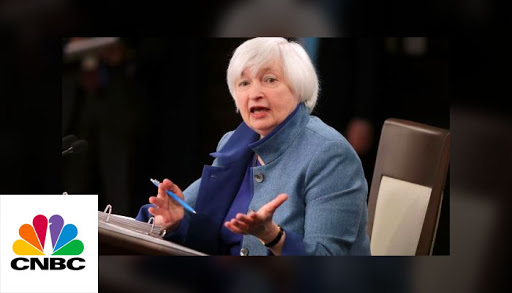WHEN: Tomorrow, Wednesday, February 6, 2019 @ 2:30PM ET
WHERE: CNBC’s “Power Lunch”
The following is the unofficial transcript of a CNBC EXCLUSIVE interview with Former Federal Reserve Chair Janet Yellen and CNBC’s Steve Liesman on CNBC’s “Power Lunch” (M-F 2PM – 3PM) today, Wednesday, February 6th. The following is link to video of the interview on CNBC.com: https://www.cnbc.com/video/
All references must be sourced to CNBC.
TYLER MATHISEN: Former Fed Chair Janet Yellen will join us now. So much to talk to her about from the strength of the economy, to interest rates, to the President’s dinner with the current Fed Chair. Chair Yellen is standing by with our own Steve Liesman. Steve, take it away.
STEVE LIESMAN: Tyler, you’re so smart. That’s the first question I had. Thanks very much. Chair Yellen, thanks for joining us.
JANET YELLEN: Thanks for having me here.
STEVE LIESMAN: So Tyler Mathisen just talking about the dinner that Chairman Powell had with the President. You met with the President a couple of times.
JANET YELLEN: Yes.
STEVE LIESMAN: President Trump. And you met with President Obama a couple of times. What are the pitfalls? Why is it such a sensitive thing for the Fed Chair and the President to meet?
JANET YELLEN: Because the Fed is independent and it’s important for the public and for market participants to understand that the actions that the Fed takes truly are in response to its congressional mandate of maximum employment and price stability. There is some history of Presidents trying to influence the Fed and reportedly, Nixon influenced Arthur Burns. So it’s important for the sake of the Fed’s credibility and confidence in the institution.
STEVE LIESMAN: Right. So why meet at all if you have those concerns?
JANET YELLEN: Well, the President is of course is concerned about the economy and it’s very natural for the President to want to hear the Fed Chair’s views on the economy and to understand that thinking.
STEVE LIESMAN: You talked about a history of criticism of Presidents of the Fed. There’s pretty recent history of that. You must see the comments that President Trump has made about the Fed and the Fed Chairman. Do you think, “Oh, wow, glad that’s not me,” or what is your sense of the propriety of that really?
JANET YELLEN: Well, I think a President has a right to express views. But there was a long history, I think it began with President Clinton went through the Bush and Obama administrations, of absolutely no comments by the President on the Fed. And of course throughout there are always communications between the Fed and the White House. I had regular meetings with Secretary Lew and Secretary Mnuchin. I know that Chair Powell also has those meetings. So there is ongoing communication with members of the President’s economic team and occasionally, the President about the economy. But it is important for the Fed to be viewed as independent. And you know, I worry that the comments threaten public confidence.
STEVE LIESMAN: Let’s leave the politics behind and talk about some of the economics right now. In December, the market seemed like they were sending a very strong signal that the economy was going to turn down this year. And the economic data kept coming in strong. Have you been in a situation like that? How do you handle the kind of market signals versus the economic data signals? What’s the right one to believe?
JANET YELLEN: Well, the economic data signals are important, but to some extent, they’re backward looking. And I think the markets tend to focus on what they see coming down the pipe. And it’s important for the Fed to be doing the same thing. So far, the economic data for the United States is solid and strong. We’ve got, as you know, about the lowest unemployment rate in 50 years, continued solid job performance, low inflation. And my own view is that with long expected growth to slow in 2019, relative to last year which probably will come in around 3% or more. And we’re seeing signs that the economy is slowing. I still expect the most likely outcome is solid growth in 2019. But there are downside – there are downside risks.
STEVE LIESMAN: What risks do you see and how do you assess them?
JANET YELLEN: Well we are seeing slowing global growth. The data from China have been reasonably weak and the European data has also come in weaker than I think had been expected. So there are those risks. There are risks stemming from trade policy, from Brexit and uncertainties around various political decision making. We’ve also seen, of course, a tightening of financial conditions and for a long time as the Fed raised short-term rates, indices of overall financial conditions were moving in the other direction. That’s now changed and we are seeing a tightening of financial conditions. So there are some things pulling down growth and less support this year than last from fiscal policy. But consumer spending is still two-thirds of all spending in the U.S. economy and with slightly higher wage gains and strong job market performance, low debt burdens, I think consumers are in good shape to carry forward growth in 2019.
STEVE LIESMAN: So there’s also a two-sided risk to the Fed acting, right? If it doesn’t act, you risk inflation. If it does, you risk recession or economic weakness. How do you judge the other side? The concern about inflation that the Fed doesn’t act that perhaps there will be an inflation problem?
JANET YELLEN: Well, I think that is something that the Fed should be aware of. We have a very low unemployment rate. Traditionally, we’ve seen linkages between the degree of labor and product market slack and inflation. And that’s a lesson of history that I think it’s important for the Fed not to forget. But on the other hand, the linkages aren’t all that strong. And it looks like over the last decade or two, the strength of the linkages between labor market tightness and wage and price inflation has become much more muted relationship. So, for example, we’ve seen wage growth move up some as the labor market has tightened, but not a lot. And wage growth is still running just around 3% or slightly over 3%. And you know, with 1% or a little bit more productivity gain, you’re not seeing pressures on firm’s profit margins, unit labor costs rising are a little under 2%. So we’re not seeing strong inflationary pressures, if any, emerge. Inflation is still running under — slightly under 2%, close but after a long period–
STEVE LIESMAN: So ultimately, sounds like you’re saying that the Fed has the luxury here of being patient and worry more about the downside risk because the upside risk to inflation is not all that present.
JANET YELLEN: I would say now that they’re in a range of neutral, that it’s not necessary to act preemptively. And many people feel there may have been more fundamental change in the relationship between inflation and the labor market. And so I’m waiting to see how does inflation evolve? Is there any evidence of upside inflation pressure? So I won’t rule out that that could happen. It’s possible, especially if we get strong growth this year and the labor market continues to tighten. It’s not out of the question that the Fed might need to raise rates again, but waiting to see. And of course there are risks on the other side. And so this is a time when being data dependent and looking at the data and assessing what it means for the outlook seems sensible to me.
STEVE LIESMAN: So would you say it’s possible the next move is a cut by the Fed?
JANET YELLEN: Of course it’s possible. If global growth really weakens and that spills over to the United States or financial conditions tighten more and we do see a weakening in the U.S. economy, it’s certainly possible that the next move is a cut, but both outcomes are possible.
STEVE LIESMAN: I’m going to push you a little further on this, just as a last question on it. If you were — you did this for a long time. So if you were filling out the SEP, the Fed’s forecast again, what would you have penciled in for 2019 for Fed policy?
JANET YELLEN: Well, I might have penciled in something similar to the median.
STEVE LIESMAN: Which is two rate hikes.
JANET YELLEN: — It was two rate hikes, but I would have had a very wide uncertainty band around it. And one of the things that my committee tried to do was to add uncertainty bans around these forecasts because it’s very important for people to realize—
STEVE LIESMAN: And the market ignores this.
JANET YELLEN: — yeah, nobody is certain what the, what will be appropriate. And I remember — what’s going on now reminds me a lot of 2015, 2016. We were on a path we thought to begin raising rates in 2015. In the summer of 2015, the Chinese devalued the Yuan. There was a tightening of financial conditions. The stock market declined. We had expected that by September of 2015, we would begin raising rates. They had been zero for seven years. We waited until December. In December, the median forecast and the dot plot looked for four increases in 2016.
STEVE LIESMAN: And you did none. Or you did one.
JANET YELLEN: We did one. In December.
STEVE LIESMAN: Let me bring it forward now, talk about the other risks out there. How big a risk are some of these trade tensions that are out there and how much concern do you have about China’s weakness hurting the U.S.?
JANET YELLEN: So I think the trade tensions if they’re not resolved, can be a significant negative for the outlook. We’re already seeing some impact on business confidence and I think we could see a negative impact on investment spending and possibility also on consumer spending. Some of the soft indicators, the sentiment indicators have weakened some. So I would worry about that and Chinese growth clearly looks to have slowed both from their numbers and the reports you’re hearing from American firms doing business there. The Chinese really want to control the growth of debt and they don’t want to stimulate spending using the tools that they have used in the past, opening up the credit taps as they did after the financial crisis. They’d like to stimulate consumer spending, but they do have policy tools and I anticipate they will use them to continue to spur growth, although growth in China is on and has been for some time, on the slowing trend.
STEVE LIESMAN: You put the reduction of the balance sheet on autopilot essentially. I don’t know if you would own up to that.
JANET YELLEN: I will confess.
STEVE LIESMAN: Will you confess to that?
JANET YELLEN: I will confess to having used that word.
STEVE LIESMAN: You used that word. You said it was as boring as watching –
JANET YELLEN: Paint dry.
STEVE LIESMAN: — paint dry. And Jay Powell used some of those terms and he got in trouble for using them.
JANET YELLEN: He did.
STEVE LIESMAN: Do you think that was a mistake and is it right now do you think for the Fed to sort of say: You know, we’re going to be a little more sensitive with the reduction of the balance sheet to what’s going on in the economy?
JANET YELLEN: Well I intended for it to be reassuring and for a long time, it seemed like it was reassuring. And the reason it was reassuring is I wanted to make sure that market participants in the public didn’t imagine that as we removed accommodation, we would be using actively two tools, two separate tools and that every time there was a meeting, we would be making decisions both about the short rate and the pace of run off. I could envision nothing more confusing. So the idea of saying: Look, we’re going to use one tool actively, short-rates. The balance sheet, we will run off very gradually and in a way that is completely predictable, we have specified in advance, there’s nothing more to learn about this. That will go on. That’s what auto pilot meant. And I thought it should be reassuring, and I think for a long time, it was. What it didn’t mean was that we wouldn’t pay attention to possible impacts of the run off on market conditions. And if there were some, well, and after all, we had bought all those assets with the idea of pushing –
STEVE LIESMAN: So you think it’s right now for the Fed to make the change and be more sensitive to the balance sheet.
JANET YELLEN: Well, I think they should make clear they’re watching carefully what the run off entails. And we’ll be sensitive. And offsetting it could mean making changes at the short-end, not necessarily immediately making balance sheet changes. But it’s probably important that signal people are not asleep and ignoring the impact of that on the economy.
STEVE LIESMAN: Janet Yellen. Thank you so much for joining us.
JANET YELLEN: Thank you for having me.
STEVE LIESMAN: Fed Chair Janet Yellen, down here from 30 Rock. Back to you guys.
For more information contact:
Jennifer Dauble
CNBC
t: 201.735.4721
m: 201.615.2787
e: jennifer.dauble@nbcuni.com
Emma Martin
CNBC
t: 201.735.4713
m: 551.275.6221
e: emma.martin@nbcuni.com










